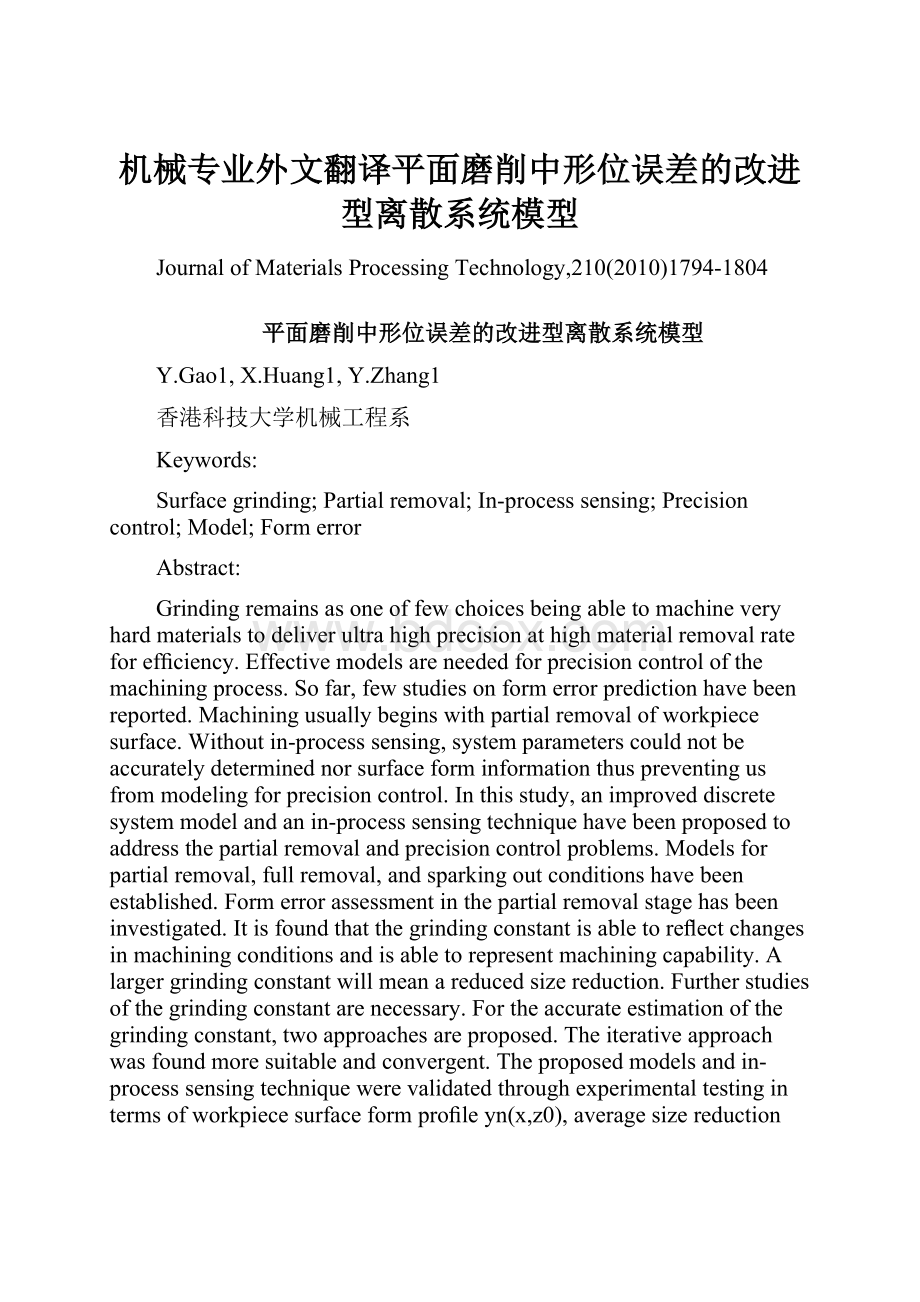机械专业外文翻译平面磨削中形位误差的改进型离散系统模型.docx
《机械专业外文翻译平面磨削中形位误差的改进型离散系统模型.docx》由会员分享,可在线阅读,更多相关《机械专业外文翻译平面磨削中形位误差的改进型离散系统模型.docx(19页珍藏版)》请在冰豆网上搜索。

机械专业外文翻译平面磨削中形位误差的改进型离散系统模型
JournalofMaterialsProcessingTechnology,210(2010)1794-1804
平面磨削中形位误差的改进型离散系统模型
Y.Gao1,X.Huang1,Y.Zhang1
香港科技大学机械工程系
Keywords:
Surfacegrinding;Partialremoval;In-processsensing;Precisioncontrol;Model;Formerror
Abstract:
Grindingremainsasoneoffewchoicesbeingabletomachineveryhardmaterialstodeliverultrahighprecisionathighmaterialremovalrateforefficiency.Effectivemodelsareneededforprecisioncontrolofthemachiningprocess.Sofar,fewstudiesonformerrorpredictionhavebeenreported.Machiningusuallybeginswithpartialremovalofworkpiecesurface.Withoutin-processsensing,systemparameterscouldnotbeaccuratelydeterminednorsurfaceforminformationthuspreventingusfrommodelingforprecisioncontrol.Inthisstudy,animproveddiscretesystemmodelandanin-processsensingtechniquehavebeenproposedtoaddressthepartialremovalandprecisioncontrolproblems.Modelsforpartialremoval,fullremoval,andsparkingoutconditionshavebeenestablished.Formerrorassessmentinthepartialremovalstagehasbeeninvestigated.Itisfoundthatthegrindingconstantisabletoreflectchangesinmachiningconditionsandisabletorepresentmachiningcapability.Alargergrindingconstantwillmeanareducedsizereduction.Furtherstudiesofthegrindingconstantarenecessary.Fortheaccurateestimationofthegrindingconstant,twoapproachesareproposed.Theiterativeapproachwasfoundmoresuitableandconvergent.Theproposedmodelsandin-processsensingtechniquewerevalidatedthroughexperimentaltestingintermsofworkpiecesurfaceformprofileyn(x,z0),averagesizereduction
cn,surfaceformerrorEpvnandnormalgrindingforceFnn.Throughdetailedexaminationandcomparativestudies,theproposedmodelsandin-processsensingtechniqueofferedsignificantimprovementsrangingfromapproximately16.9%to23%,comparedwiththeexistingmodels.Exceptthegrindingforce,whichwasindirectlymeasuredthroughavoltagemeasurementapproach,theoverallrelativeerrorsbetweenthetheoreticalresultsandtheexperimentalresultsunderfullremovalconditionswerefoundrangedfrom2.08%to6.87%,indicatingtheimprovedprecisionpredictioncapabilitiesoftheproposedsystemmodel.Theexperimentalresultscanbeusedasasetofreferencesforfurtherstudiestoofferperformanceassessment,precisionprediction,processplanning,andprocessconditionmonitoringforthisimportantprecisionmachiningprocess.
1.Introduction
1.1.Modelforprecisioncontrol
Grindingisanabrasiveprecisionmachiningprocesswhichremainsasoneoffewchoicesbeingabletomachineveryhardmaterialstodeliverultrahighprecisionathighmaterialremovalrateforefficiency.Processofthekindiswidelyusedtoachievehighaccuracyforhighqualitymechanical,electrical,andopticalparts(KarpuschewskiandInasaki,2006).Surfacegrindingisoneforprecisionmachiningofsurfaces.Toachievehigheraccuracyforqualitycontrol,itisessentialtodevelopeffectivemodelstorealizeprecisioncontrolofthemachiningprocess.
Forgrindingprocessmodeling,modelsofmultipleaspects(BałaszandKrólikowski,2007),suchasmodelofgrain(Horng,2008;Mamalisetal.,2001),modelofgrindingwheeltopography(Bigerelleetal.,2005;ZhouandXi,2002),modelofheattrans-fer(Liaoetal.,2000),modelofprocesskinematics
(Wecketal.,2001;Zhangetal.,2005),modelofchipformation(GopalandRao,2004;Heckeretal.,2007),modelofforce(HekmanandLiang,1999;JenkinsandKurfess,1999;Tangetal.,2008),andmodelofpower(Nandiaetal.,2004),havebeenexamined.Thegrainormaterialremovalmodel(Horng,2008)wasbasedonsurfaceasperitycontactmechanics.Theelastic–plasticeffectsinthewearmechanismwereconsideredtoberelatedtothedensityofabrasivegrains.Mamalisetal.(2001)proposedamodelforinteractionbetweenhardpolycrystallinematerialsandwheelgrainduringgrinding.Wornsurfacesofgrindingwheelmaybemodeledusingfractalfunctions(Bigerelleetal.,2005).Aroughnesspredictionmodelforwheeltopography,wear,andgrindingkinematicswasestablishedbyZhouandXi(2002).ThethermalmodelbyLiaoetal.(2000)involvedathermaleffectofgrainandworkpieceinterfaceandashearplanebetweenworkpieceandchip.Thetemperatureoftheworkpiecesurfaceinthegrindingzonecouldbepredicted.Adynamicbehaviormodelforthecylindricaltraversegrinding
processinthetimedomainwaspresentedbyWecketal.(2001).AnonlineardynamicmodeltoinvestigatethedynamiccharacteristicsofthegrindingprocesswasproposedbyZhangetal.(2005).AchipthicknessmodelbyGopalandRao(2004)wasdevelopedforassessmentofsiliconcarbidegrindingbyincorporatingthemodulusofelasticityofthegrindingwheel.Basedonthestatisticaldistributionofundeformedchipthickness,predictivemodelsforgrindingforceandpowerwereproposedbyHeckeretal.(2007).Tocontrolthedepthofcut,agrindingforcebasedmodelmaybeused(HekmanandLiang,1999).Arealtimegrindingforcemodel(JenkinsandKurfess,1999)wasusedtocontrolthegrindingnormalforce.Theslidingforcemodelforsurfacegrinding(Tangetal.,2008)involvedprocessparametereffectsonfrictioncoefficient.Forpowerrequirementandsurfacefinishprediction,aGA-fuzzymodelmaybeused(Nandiaetal.,2004).
1.2.Formerror
Itcanbeseenthatthemodelspreviouslyexaminedaremainlyrelatedtoroughness,power,heat,chipthickness,anddynamiccharacteristicsinagrindingprocess.Formerror,asoneofthemostcriticalqualityelementsofaworkpieceamongsize,formandroughness(Whitehouse,2002),remainsadifficultissue.Veryfewexistingstudiesonformerrorpredictionforsurfacegrindingcanbefound.
1.3.Partialremovalproblem
Foratypicalsurfacegrindingprocess,duetoinitialsurfaceprofileerrorandmisalignmentinvolvedinworkpieceandworkpiecemounting,machiningusuallybeginswithpartialremovalofworkpiecesurface(Fig.1).Ifthisconditionisnotexaminedasinourpreviousmodel(HuangandGao,2010),wewillexperienceasignificantamountoferrorinpredictionofformaccuracyinthemachiningprocess(HuangandGao,2010).Assuch,ourabilityforprecisioncontrol(GaoandJones,1993),whichisverydesirable(Ludwicketal.,1999;KimandTrumper,1998),couldbereduced.
1.4.In-processsensingproblem
Inourpreviousmodel(HuangandGao,2010),in-processmeasurementdevelopedbyGaoetal.(2009,2010)wasnotavailableandtheinitialworkpieceprofiley0(x,z)wasassumedtobezero.Becauseofthis,wecouldnotaccuratelydeterminesystemparametersandwecouldnotacquireaccuratesurfaceforminformation,whichcouldpreventusfrommodelingthemachiningprocessforprecisioncontrol(GaoandJones,1993;HuangandGao,2010),whichismuchdesired(Ludwicketal.,1999;KimandTrumper,1998).Inourprevioustest(HuangandGao,2010),themachiningprocesswasnotfullymodeled.Themaximummodelingerrorwasupto19.9%(HuangandGao,2010).
1.5.Improveddiscretesystemmodelandin-processsensingtechnique
Inordertosolvetheaboveproblemstoachievehighermodelingaccuracyforprecisioncontrol(GaoandJones,1993;HuangandGao,2010),anewin-processsurfaceformprofilemeasurement
prototypesystem(Gaoetal.,2009,2010)wasdeveloped.Aftertheuseofthein-processformerrorsensor,accurateparameterestimationandtheconditionofpartialremovalwillbeincludedinan
improveddiscretesystemmodel,whichisproposedforthesurfacegrindingprocess.Theimproveddiscretesystemmodelwillbeexamined.Theproposednewmodelandin-processsensingtechniquewillbeusefulunderbothpartialandfullremovalconditions.Itcanbeusedtopredictworkpieceformerrorthroughoutagrindingprocess.Inaddition,theimprovedmodelwillallowadvancedcontroltoachievehighefficiencyinultraprecisionandnanoprecisionmachining.
2.In-processformerrormeasurement
Foraccurateparameterestimationandidentificationofpartialremovalcondition,in-processmeasurementofformerrorprofileyn(x,z)(Fig.1)willbeusedtoenhancemodelingaccuracy.Withoutthein-processformerrormeasurement(Figs.1and2),theworkpiecehastoberemovedfromthemachiningpositiontomeasureofflinetoobtaintheinitialworkpieceprofiley0(x,z).Asignificantamountoferrorwascausedastheworkpiecehastobemountedagainaftertheofflinemeasurement(HuangandGao,2010).ThisisparticularlytruefornonferrousmaterialssuchasAl,Cu,andSiwhicharecommonlyusedwheremagneticchuckwillnolongerbefunctional.
2.1.Prototype
Toavoidthescratchprobleminthecontactapproach(Whitehouse,2002),anewopticalin-processsurfaceformmeasurementprototypesystemhasbeendevelopedandhasbeenusedonarealsurfacegrindingmachine(Fig.2)(Gaoetal.,2009,2010).Themeasurementsystemismainlymadeupofatriangularlasersensor,applicatorandairpiece.ThetypeofthelasersensorisCyberOpticsDRS300.Ithasaresolutionof50nmandisusedtomeasureworkpiecesurfaceformprofileyn(x,z)(Figs.1and2).Theapplicatorisforreducingtheamountof
coolantnearthemeasurementregion(Fig.2).Thiswillbebeneficialforestablishingatransparentwindowforopticalmeasurement.Theairpieceistoallowanairbeamtobeejectedandthenimpingedontheworkpiecesurfacetoremovecoolant.Thesystemisthefirstoneofthetypeforworkpieceformprofilemeasurementforwhichthecoolantproblemthatpreventsuseofhighprecisionopticalapproachwassolved(Gaoetal.,2010).
2.2.Opaquebarrierandvibration
Duetotwokeyproblems,whichareopaquebarrierandvibration(Gao